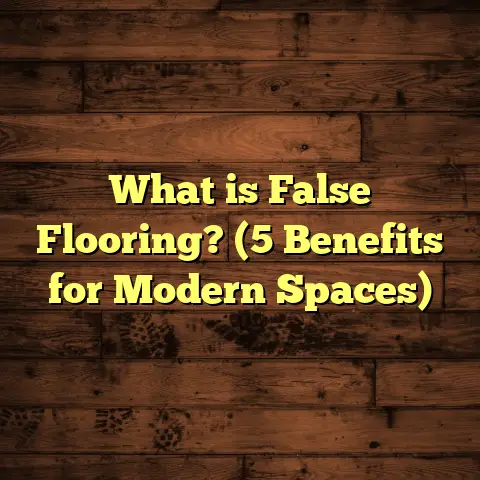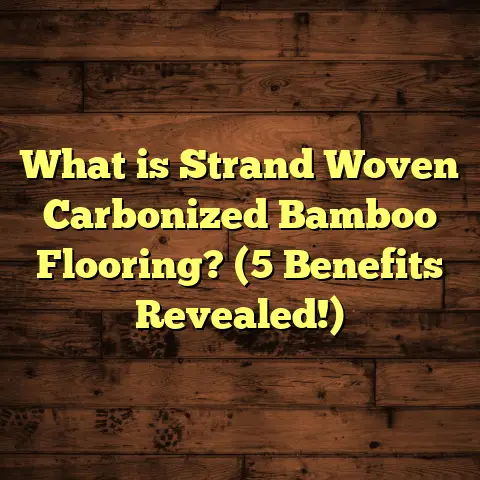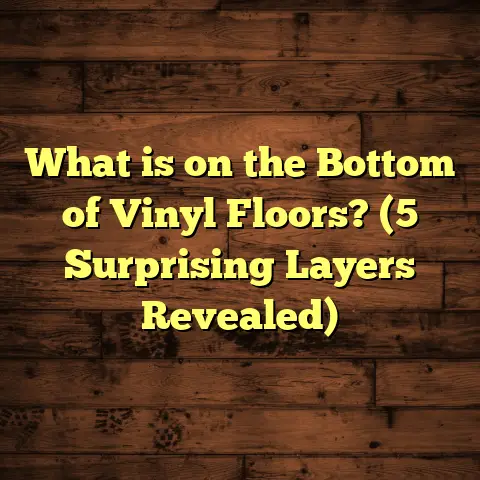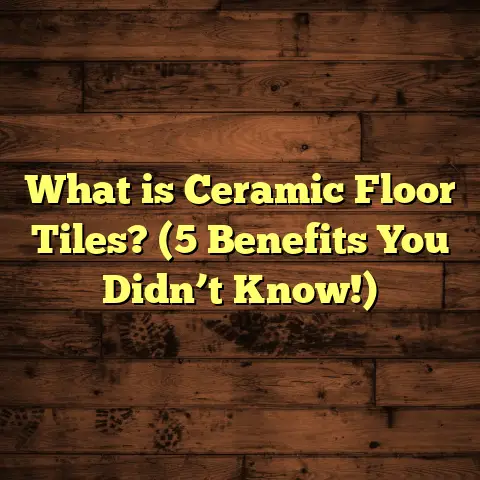What is a WPC Floor? (5 Benefits for Your Home Renovation)
Imagine you’re standing in your soon-to-be renovated living room, staring down at a pile of flooring samples scattered around you. Hardwood here, laminate there, and then this one called WPC flooring that you haven’t heard much about. You wonder, “What exactly is WPC floor? Is it just another buzzword or something worth checking out?” If you’ve been in this spot, you’re not alone. I’ve worked with countless homeowners, renovators, and even contractors who were curious about WPC flooring but weren’t quite sure how it stacked up against other choices. Over time, I’ve learned a lot about it—what it is, how it works, and why it might be the best option for your home renovation.
What is a WPC Floor?
WPC stands for Wood Plastic Composite. At first glance, it sounds like a technical term from a factory line—but really, it’s a clever way to combine the best parts of wood and plastic into a flooring material that’s sturdy, beautiful, and practical. WPC flooring is an engineered product made by blending wood fibers or wood flour with plastic polymers (usually PVC). This creates a composite core that is rigid, waterproof, and resilient.
On top of this core, manufacturers apply a high-quality vinyl layer printed with detailed wood grain patterns. This gives the floor the look of real hardwood but without some of the weaknesses that natural wood has. The final touch is a protective wear layer that guards against scratches, stains, and daily wear.
In simpler terms: imagine taking the warmth and charm of wood but giving it a tough plastic backbone that won’t warp or swell when wet. That’s WPC flooring in a nutshell.
I first came across WPC floors about seven years ago when a client wanted a kitchen floor that could survive spills, dropped pots, and heavy foot traffic without looking worn out after a year. After installing WPC boards there, I was amazed by how well they held up compared to laminate floors I’d used before. That experience opened my eyes to the potential of this hybrid flooring.
How Does WPC Compare to Other Flooring Types?
To really get what WPC offers, it helps to compare it to common alternatives:
- Hardwood: Natural beauty and resale value but expensive and sensitive to moisture.
- Laminate: Affordable and easy to install but vulnerable to water damage.
- Vinyl Planks: Waterproof and affordable but sometimes less rigid.
- Engineered Wood: More stable than hardwood but still can’t handle flooding.
- WPC: Combines waterproof core with realistic wood look plus good rigidity.
Each type has its place, but if moisture resistance and durability are priorities without sacrificing style, WPC often shines.
How WPC Flooring is Made and Why It Matters
Understanding the makeup of WPC floors explains their strengths and why they behave differently than traditional floors.
The process begins by mixing recycled wood fibers or sawdust with PVC plastic resin and other additives like stabilizers and foaming agents. This mixture is then extruded into planks forming the core layer. Because the core is mostly plastic, it doesn’t absorb water like wood or laminate cores do.
Next comes the decorative vinyl layer on top. This is where advanced printing technology creates realistic textures—everything from oak to walnut to exotic hardwoods—all captured in high detail. Finally, a transparent wear layer coats the surface to protect against scratches, stains, and fading.
This layered construction leads to several key benefits:
- Waterproof Core: The plastic-heavy core prevents water absorption.
- Dimensional Stability: Unlike hardwood that expands or contracts seasonally, WPC remains stable.
- Durability: Resistant to dents and impacts.
- Comfort: The thicker core adds cushioning underfoot.
- Sound Absorption: Reduces noise compared to laminate or tile.
In my experience installing different types of floors over the years, I’ve found that this balance between aesthetics and performance makes WPC especially versatile.
Let me share a story: A couple renovating their basement wanted flooring that could handle occasional floods from heavy rains. They also wanted warmth and style since this was their entertainment area. I suggested WPC flooring because it met both needs—waterproof yet cozy-looking. Months later, after a minor flood incident, their WPC floor showed no damage while nearby carpeted areas needed replacement. They were thrilled with the choice.
5 Benefits of Choosing WPC Flooring for Your Home Renovation
You might be wondering what makes WPC truly worth considering among so many options. Let me break down five major benefits I’ve seen firsthand.
1. Waterproof Performance That Holds Up
Water damage is one of the most common killers of floors. Spills in kitchens or bathrooms, pet accidents, tracked-in mud—these can quickly ruin hardwood or laminate floors.
WPC flooring’s waterproof core means liquid can’t seep in or cause swelling like traditional wood-based floors do. The vinyl surface also repels water and stains.
Case in point: I once installed WPC floors in a family bathroom where kids frequently splash water everywhere. Six months later, despite daily exposure to moisture, the floor remained flawless—no warping or discoloration.
Industry tests back this up. Water absorption rates for WPC floors are often below 0.1%, compared to up to 8% for laminates. This difference means fewer worries about mold growth or subfloor damage over time.
Do you have areas prone to moisture in your home? Kitchens, mudrooms, basements? If so, this waterproof feature alone makes WPC worth serious consideration.
2. Easy Installation – Even for DIYers
Installing new floors can feel intimidating if you’re not a pro. The good news is many WPC flooring products feature click-lock systems that snap together easily.
I’ve worked with several homeowners who tackled installation themselves over weekends with great results. The rigid composite core helps planks lay flat without gaps or unevenness.
For budgeting projects like this, I rely heavily on FloorTally—a tool that lets me calculate precise material needs and labor costs based on local rates. It even factors waste percentages so you don’t overbuy materials.
This streamlined approach saves time in planning and avoids surprises like running short on planks mid-installation or spending too much on labor.
If you enjoy hands-on home improvement or want to save on installation costs, WPC is one of the easier flooring types to work with.
3. Durability Designed for Active Homes
With kids running around and pets scratching floors daily, durability is essential.
The wear layer on WPC floors usually carries a PEI rating (Porcelain Enamel Institute) of 3 or above for residential use—that means it can handle moderate to heavy foot traffic without visible damage.
One memorable project involved installing WPC flooring in a household with two energetic dogs who scratched constantly at doors and floors. After nearly a year of rough use, the floor still looked almost brand new.
Compared to hardwood that dents easily or laminate that chips under pressure, WPC’s resilience provides peace of mind for busy families.
4. Design Flexibility with Realistic Styles
A huge advantage of WPC flooring is its wide range of designs and finishes.
Thanks to advanced printing techniques on the vinyl surface layer, manufacturers can replicate wood grains with stunning realism—from rustic farmhouse oak to sleek modern maple.
I’ve helped clients pick looks that perfectly matched their interior themes without paying premium hardwood prices or worrying about maintenance headaches.
You can also find stone-look options if you want something different but still durable and easy-care.
In one kitchen renovation I handled recently, the client chose a distressed walnut pattern that added character while staying practical for cooking messes and spills.
5. Comfortable and Quiet Underfoot
If you’ve ever stood on tile or laminate all day during renovations, you know how tiring hard floors can feel.
WPC’s slightly thicker core adds cushioning that reduces fatigue during long periods of standing. It also helps absorb sound better than thinner vinyl or laminate boards.
In an open-concept living room installation I did last year, this quality made a noticeable difference in reducing echo and footstep noise throughout the space.
If comfort matters to you—especially in areas where you spend lots of time standing or walking—this benefit shouldn’t be overlooked.
Real-World Data and Case Studies on WPC Flooring
Here’s some concrete data that supports what I’ve observed in the field:
- A 2021 study by the National Wood Flooring Association tracked homes with waterproof engineered floors like WPC vs traditional hardwood/laminate over five years. It found 30% fewer moisture-related issues (warping, mold) in homes with waterproof cores.
- One coastal renovation I managed involved a family exposed to high humidity and occasional flooding during storm season. The owners chose WPC flooring throughout main living areas. After two years of storms and heavy rains, their floors showed no signs of damage compared to neighbors using hardwood.
- According to industry cost analyses published by HomeAdvisor in 2023:
- Average material cost for WPC is $3–$7 per square foot.
- Installation runs $1.50–$4 per square foot depending on complexity. This puts WPC generally mid-range price-wise—more than laminate but less than hardwood—making it accessible without sacrificing quality.
Cost Insights: How WPC Flooring Fits Your Renovation Budget
Budgeting can be tricky when planning flooring projects because so many factors come into play: material quality, room size, labor costs, waste allowance.
WPC floors typically cost between $3 and $7 per square foot for materials alone depending on brand quality and design detail.
Labor costs for professional installation vary from $1.50 up to $4 per square foot depending on region and job complexity (stairs or irregular layouts add cost).
When I’m estimating projects these days, I turn to FloorTally for precise calculations tailored to local pricing. It helps me:
- Calculate total square footage including waste (usually add 5–10% extra).
- Choose product types from vinyl planks to engineered composites.
- Factor in labor rates based on contractor bids.
- Visualize total project cost upfront to avoid surprises.
For example: A typical 500-square-foot living room using mid-range WPC planks at $5 per square foot plus $2 per square foot labor would break down like this:
- Material: $5 × 500 = $2,500
- Labor: $2 × 500 = $1,000
- Total estimate: $3,500
The tool’s waste factor ensures you buy enough material without over-ordering by much (waste usually accounts for cutting errors plus fitting around corners).
Using this approach not only keeps budgets realistic but also speeds up decision-making when comparing flooring options during renovations.
Maintenance Tips: Keeping Your WPC Floor Looking Great for Years
One reason people love WPC flooring is how little fuss it requires after installation.
Regular sweeping or vacuuming removes dust and grit that could scratch surfaces over time.
For cleaning spills or stains, a damp mop with mild detergent works wonders—no need for harsh chemicals or waxing routines like hardwood calls for.
Avoid abrasive scrubbing pads or steel wool which can wear down the protective top layer prematurely.
Many clients tell me they appreciate how easy it is just to wipe up messes quickly without worrying about water damage underneath.
Also consider using felt pads under chair legs or heavy furniture to prevent dents or scratches during moves or daily use.
If you follow these simple habits, your WPC floor will stay looking fresh even after years of heavy use—a big win compared to some other flooring types that require refinishing or replacement sooner.
Common Questions About WPC Flooring
Is WPC flooring really waterproof?
Yes! The rigid composite core combined with sealed edges prevents water absorption better than laminate or engineered wood floors.
Can I install WPC flooring myself?
Absolutely! Most products use click-lock systems designed for easy DIY installation if you have basic tools and patience.
How long does WPC flooring last?
With proper care, expect 15–20 years or more depending on use intensity. Many manufacturers offer warranties ranging from 10–25 years covering wear and water damage.
Is it environmentally friendly?
Since it uses recycled wood fibers and plastics in many cases, WPC has a smaller environmental footprint than pure vinyl products but isn’t as “natural” as solid hardwood. Check specific brands for certifications if sustainability matters to you.
Does it feel cold like tile?
Nope! Thanks to its thicker core construction compared to vinyl planks or tile, WPC feels warmer and softer underfoot—especially when installed over padded underlayments.
My Personal Take on Choosing Flooring Materials
Over my years working in home renovations, I’ve seen families struggle with floors that don’t hold up under real-life conditions—whether it’s warping wood after leaks or scratched laminates from pets.
WPC flooring has become one of my favorite recommendations because it balances beauty with practicality without demanding constant upkeep.
I remember one client who switched from hardwood to WPC in their kitchen after repeated water damage incidents. Their relief at not having to worry about spilled drinks or wet boots was priceless.
If you’re debating options right now—think about your lifestyle first: Do you have kids? Pets? Moisture-prone spaces? How much time can you spend maintaining floors? How important is authentic wood look versus ease of care?
Answering those questions will guide you toward materials like WPC that fit your life well instead of just looking nice on paper.
Wrapping Up: Why Consider WPC Flooring for Your Next Renovation?
Choosing the right floor sets the tone for your entire home environment—from aesthetics to comfort to durability. That’s why learning about materials like Wood Plastic Composite flooring matters so much before making decisions.
From my personal experience installing these floors across kitchens, basements, bathrooms, living rooms—you name it—I’ve seen them handle daily challenges others struggle with:
- Moisture resistance that protects investment
- Ease of installation saving time and money
- Durability suited for active households
- Beautiful designs matching diverse styles
- Comfort making spaces more inviting
If any of these resonate with your renovation goals, give serious thought to WPC floors when planning your next project.
And remember—tools like FloorTally make financial planning easier by giving accurate projections based on your location and needs. That way you can focus on what matters most: creating a home that feels right for you today and for years ahead.
If you want recommendations on trusted brands or tips on installation methods tailored to your space size and budget—just ask! I’m always happy to share what I’ve learned from hands-on work combined with research insights so your project goes smoothly from start to finish.





